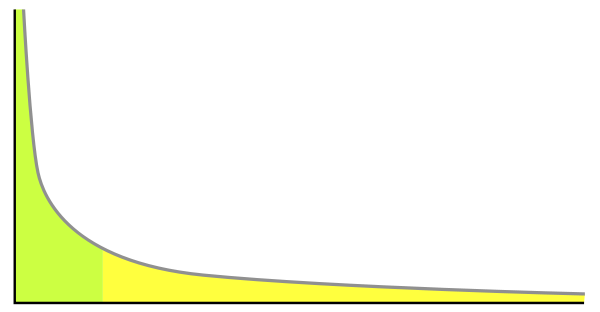Life, School, and the 80:20 Rule
September 25, 2019
Most people sense that school today is poor preparation for the world of work. I think there is a fundamental reason why: linearity.
School is a linear system. By that, I mean the material in classes is presented sequentially, in more or less equally-sized chunks. My school called these chunks “units”. In maths, the functions unit came before the differentiation unit, and so on. At the end of a unit there was always a test. Supposedly, the purpose of the test was assessment: tracking students’ progress. But a secondary outcome was standardising the speed of learning. Regardless of whether students forged ahead with the material or hung behind, they all had to take the same test at the same time. The structure of school calcifies the pace of learning, forcing students to march to the regular ring of the bell.
School rewards effort linearly as well. For example, when required to write essays, my school provided us with a mark scheme: a set of criteria which specified what “competencies” we had to demonstrate in order to achieve a certain grade. If you used 10% more “advanced vocabulary words” you’d get into the next grade band. If you only used one or two good transitions you’d fall into a lower grade band. The mark scheme suggested small improvements to make to our writing, which gave small, predictable increases in our grades.
The best writers ignored the mark scheme almost entirely, and just tried to be clear and interesting. This irritated me at the time: how could someone get top marks on an essay without using advanced vocabulary words? Teachers didn’t have a good answer, but they knew a good essay when they saw one. And we did too.
Looking back on it, most of our essays were not good. They were rubbish. Mark schemes provided a way of ranking all the shit essays, while the best ones soared to the top, irrespective of the grading criteria. For years, this confused me. But now I finally understand why.
Unlike school, the real world is nonlinear. By that, I mean most of what you do at work is a waste of time. In a nonlinear system, putting in 10% more effort does not result in 10% more reward. Instead, it depends on a scaling factor, which is different for each type of task. Putting 10% more effort into writing the first line of a cold email could be the difference between getting a job opportunity or not. Conversely, it doesn’t matter if you put 10% or 50% more effort into rewriting your CV; if the recipient doesn’t read it, your work was wasted. A few actions you can take have very high potential returns, while most have barely any at all.
This nonlinear relationship between effort and reward is called a power law. We rarely discuss power laws in school, but they are ubiquitous in life. The frequency of words in books, the sizes of public companies, and the relationship between gravitational force and distance all follow power laws.

Power law distributions have a long tail, which contains all the events which have minimal impact, and a sharp peak, which contains the few events that dominate the distribution. This is codified in the 80:20 rule. Around 80% of cited papers are written by 20% of scientists, for many companies, 80% of revenue comes from 20% of the customers, and in your own life, 80% of the rewards come from 20% of your effort.
Power laws are highly unequal, which might be why schools try to hide them. Some kids learn faster than others. If the quickest kids weren’t constrained by school, their learning would take off, and we’d see a power law distribution in ability. There would be a few kids at the top, and a long tail of many who couldn’t keep up. Instead, the rigid structure of most schools imposes linearity upon a nonlinear process, preventing power laws of ability from forming.
If you pay attention, you can still see power laws in schools bubbling under the surface, like the one I spotted in my english class. Myself and most of my peers formed the long tail, the pile of almost indistinguishably mediocre essays, while a few enlightened students wrote the only good essays in the class. Power laws in sporting ability are perhaps the easiest to see. A few athletic kids spend the most time training and playing sport. Their extra practice compounds over time, and they end up several times better than the median child.
School conditions us to believe that with more effort you get more results. A consequence of this conditioning is that we feel we are being productive when we are merely busy. Life’s nonlinearity means most busywork is noise.
To take advantage of nonlinearity, apply the 80:20 rule in your life. Take time to work out which activities you have natural aptitude for and enjoy the most, and focus your energy there. With time and effort, skill will compound, and you’ll leave the long tail behind, summiting the peak of the power law distribution.
Thanks to Ned Davies and OneShotFinance for helpful comments.